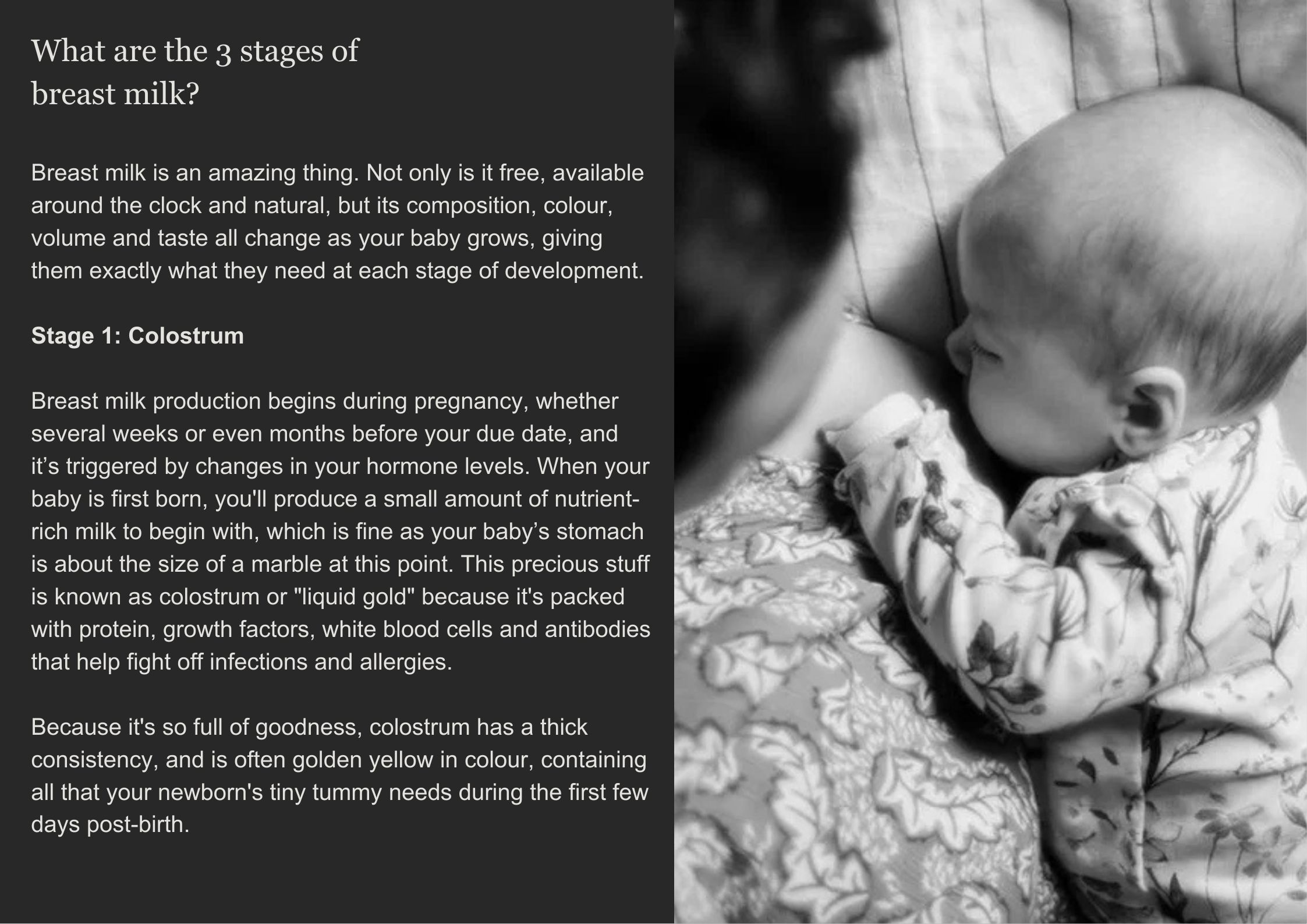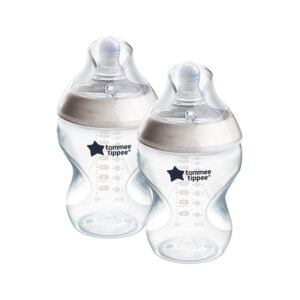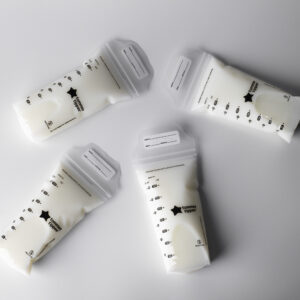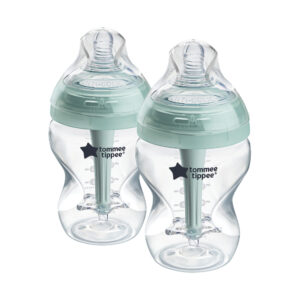Newborn & Baby

The stages of breast milk
The stages of breast milk

- The 3 stages of breast milk are colostrum production, transitional milk and mature milk. Colostrum is produced when your baby is first born and it’s full of all the key nutrients and antibodies babies need for development and to fight off infections. Transitional milk is produced around 5 days after birth and is more calorific, whereas mature milk comes in around the 2-week mark and is higher in fat and carbohydrates.
We all know that the first few weeks with your newborn are a whirlwind ride. From adapting to nighttime wake-ups to getting to grips with breastfeeding, the list goes on. And there’s no denying that every breastfeeding experience is different.
So, to give you a clear view of what’s to come, we’ve put together this guide of the different stages of breast milk production, and it’s benefits to help you through the process.
What is ‘let-down’?
Let-down is just another word for the release of milk from the breast, and despite its negative name, it’s actually pretty magical!
It’s a natural reflex that’s triggered, causing your body to react and send a message to your brain to release the hormones prolactin and oxytocin. The speed at which it happens varies from mum to mum. Sometimes, even looking at your baby or hearing them cry can trigger it, so it’s always handy to have some breast pads ready to go.
Stage 2: Transitional milk
Around 5 days after birth, the second stage of breast milk production begins, and usually lasts for 2-3 weeks. You may hear this referred to as your milk “coming in”. During this breast milk stage, you’ll begin to produce more calorie-rich milk for your baby as they develop a larger appetite, and this’ll help them to gain back some of the weight that they lost after birth.
Seeing as the milk produced in this stage is a mix of colostrum and mature milk, it’s colour and consistency can vary and will continue to change as time goes on. It’s also common to experience engorgement during this stage, which can be painful and uncomfortable.
To relieve the symptoms of engorgement you can:
- use a cold compress to ease swelling
- apply a heat pack to help the flow of milk
- try expressing a small amount of breast milk before feeding using a breast pump
Stage 3: Mature milk
By the time that your baby is around 2 weeks old, the breast milk you produce is known as mature milk. It’s lower in protein but higher in fat and carbohydrates, and is often white, light yellow, or blue-tinged in colour. The milk available when your baby starts each feed is known as foremilk, and hindmilk is the milk your baby gets at the end of a feed. How much you produce adjusts according to your baby’s habits and needs.
Mature milk is packed full of everything your baby needs for healthy growth and development for the first 6 months of their life, and you can continue to breastfeed as your baby begins to explore solid foods. If you or your baby is under the weather, your milk can even adapt to support your baby’s immune system. What’s more, it’ll continue to be produced until you decide to stop breastfeeding.
Established lactation
Around 4 weeks, milk supply typically stabilises and is regulated by demand. From here on, regular removal of breast milk, whether by breastfeeding or pumping, is what helps keeps production steady.
Breast milk (and your supply) changes hour by hour
It’s normal for your breast milk supply to ebb and flow through the day. Many parents notice they product (and can express) more in the morning.
And breast milk changes with your baby’s needs throughout the day…
- Good morning, baby: Morning breast milk often contains higher levels of cortisol (a hormone that naturally helps your baby wake up and feel alert). It’s watery, to help rehydrate them. Morning milk contains low levels of an amino acid called tryptophan (a component of the sleep hormone melatonin) and at night, these levels increase. This helps your baby to establish their circadian rhythm of being awake during the day and asleep at night.
- Night-night feed: Evening breast milk is naturally higher in melatonin and often richer in fat. This helps baby feel calm, sleepy, and satisfied, and can support steady sleep cycles.
One feed, two types of milk.
- Foremilk: Produced at the start of a feed. It’s light and hydrating to quench baby’s thirst.
- Hindmilk: Comes towards the middle and end of a feed. It’s richer, creamier and more filling.
Can breast milk be different colours?
Yes. Breast milk can shift shade and change colour more often than you’d expect, and most of the time it’s completely normal.
At the start of a feed, it’s usually thinner and may look pale or bluish, that’s the refreshing, thirst-easing foremilk. As the feed continues, it typically turns richer and more golden as the fattier hindmilk comes through.
Your diet can play a part too. Leafy greens can give it a slight green hue, while beetroot may nudge it towards pink. Occasionally, small amounts of blood from cracked nipples or a harmless condition called “rusty pipe syndrome” can give milk a reddish or even rusty tone. And if the milk looks brown or nearly black, it’s often linked to certain medications or blood from deeper within the breast ducts.
If you ever spot red or very dark milk and you’re unsure why, it’s absolutely fine to check in with a healthcare professional. But most colour changes are simply your body doing what it needs to do to nourish your baby.
Final thoughts
Now that you know what to expect from the stages of breast milk, we hope you feel more prepared for what’s to come. Remember, if you feel something doesn’t feel or look quite right, you’ve always got the support of your healthcare provider or your lactation consultant.






































